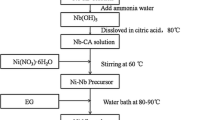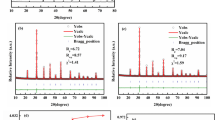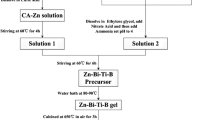Abstract
The effects of (Na0.5Bi0.5)TiO3 (NBT) and MgO addition on the dielectric properties and microstructures of BaTiO3 (BT) ceramics were investigated. NBT was first added to Nb2O5-doped BT system. As NBT content increases from 0 to 0.2 mol, the Curie temperature of the systems shifts to high temperatures and dielectric constant peak at T c is suppressed evidently. The variation of capacity (ΔC/C 20 °C (%)) of the system at 200 °C decreases with increasing NBT content from 0.1 to 0.2 mol, but that of −55 and 125 °C increases monotonously. The stable temperature characteristics of the dielectric properties improved by NBT doping would be connected with the distortion and deformation of the structure induced by substitution of Na+ and Bi3+ into Ba sites. MgO was employed to further flatten the ΔC/C 20 °C–T curve. It is very helpful for this ceramic system to satisfy the requirement of EIA-X9R specification on ΔC/C 20 °C and still keep a satisfied dielectric constant. The addition of MgO improved effectively the temperature stability of the dielectric properties. Changes of the crystalline structure and microstructure induced by MgO doping might contribute to these improvements.






Similar content being viewed by others
References
Li Q, Qi JQ et al (2001) J Eur Ceram Soc 21:2217
Li B, Zhang SR et al (2007) J Mater Sci 42:5223. doi:10.1007/s10853-006-0604-8
Chen RZ, Wang XH, Gui ZL, Li LT (2003) J Am Ceram Soc 86:1022
Chen RZ, Wang XH, Li LT, Gui ZL (2003) Mater Sci Eng B 99:298
Wang S, Zhang SR et al (2006) Mater Lett 60:909
Wang S, Zhang SR et al (2006) J Mater Sci 41:1813. doi:10.1007/s10853-006-2951-x
Song YH, Hwang JH, Han YH (2005) Jpn J Appl Phys 44:1310
Jung YS, Na ES, Paik U, Lee J, Kim J (2002) Mater Res Bull 37:1633
Smolenskii GA, Isupo VA, Agranovskaya AI (1961) Sov Phys Solid State 2:2651
Takenaka T, Maruyama K, Sakata K (1991) Jpn J Appl Phys 30:2239
Suchanicz J, Kusz J, Böhm H (2003) Mater Sci Eng B 97:154
Gao LF, Huang YQ et al (2007) Ceram Int 33:1041
Takeda H, Aoto W, Shiosaki T (2005) Appl Phys Lett 87:102104
Suchanicz J, Kusz J et al (2003) J Eur Ceram Soc 23:1559
Park JS, Han YH (2007) J Eur Ceram Soc 27:1077
Kishi H, Kohzu N et al (1999) J Eur Ceram Soc 19:1043
Acknowledgements
This work was supported by Program for New Century Excellent Talents in University (NCET) and 863 program (2007AA03Z423) and China Postdoctoral Science Foundation.
Author information
Authors and Affiliations
Corresponding author
Rights and permissions
About this article
Cite this article
Li, Lx., Han, Ym., Zhang, P. et al. Synthesis and characterization of BaTiO3-based X9R ceramics. J Mater Sci 44, 5563–5568 (2009). https://doi.org/10.1007/s10853-009-3779-y
Received:
Accepted:
Published:
Issue Date:
DOI: https://doi.org/10.1007/s10853-009-3779-y




